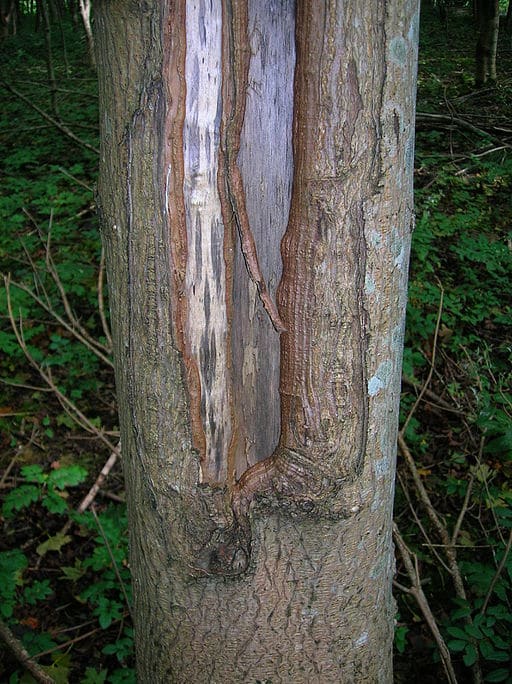Frost Crack, what is it and what can be done to remedy it? Often during the fall and winter months the temperatures drastically change between the daylight and nighttime hours. Due to these large dips and upswings in the temperature you may notice significant vertical cracks in the trunks of your trees. This is frost crack. 
Why Does Frost Crack Happen?
When the temperatures get super cold the bark on the trees naturally contract and if the temperature warms back up again during the peak of the day the bark will expand again. Frequent contracting and expanding with drastically changing temperatures cause the tree to crack.
Is Frost Crack a Reason for Concern?
Though it may look concerning, a tree with a crack is in no immediate danger and can live for several years.
Other Causes of Trunk Cracking
Frost Crack is not the only possible cause of a crack in a tree. Sunscald is another condition that causes cracks in tree trunks. Sunscald happens in the late winter and early spring when warm afternoon sun shines down on the tree and causes the tree tissue to break dormancy. If these sunny afternoons are followed up with a freezing night the tissue will begin to die. Another visible sign of sunscald is strips of bark peeling off the tree. Dark- colored and smooth-bark trees are more likely susceptible to sunscald.
Tree trunks can also crack when they are planted in geographical areas where they are only marginally hardy. Every type of tree has optimal climate conditions that it thrives in and if a tree is planted in an area where it is able to survive, but not necessarily thrive, it can crack with the less than ideal conditions for that tree.
How to Fix Frost Crack
Unfortunately, there really is no fix for frost crack. There are some gardening products on the market in the form of sealants, wound paint, and adhesives, but they do nothing to heal or boost the fitness of the tree. Keep the crack open and clean to prevent infection. The tree may attempt to heal itself by forming a callus along the crack.
Preventing Re-Occurrence
If a trunk has cracked, it is highly likely it will crack again and most likely in the same location as the first. You can attempt to prevent more cracking by wrapping the tree trunk in a tree wrap during the winter or anytime when night temperatures reach a freezing point and warm during the day. Remove the tree wrap as soon as temperatures begin to warm up and even out again. If the wrap is left on the tree longer than needed, it can create a cozy home for insects and disease to take up residence.
Planting evergreen shrubs (bushes that are green year round) around the tree trunk is another way to help prevent frost crack in trees. The shrubs help to insulate the tree trunk and protect from the harsh effects of extreme temperatures, as well as shield the trunk from direct sunlight.
Pruning the canopy of the tree and surrounding trees conservatively will also help to keep the tree trunk shaded from direct sun exposure.
If you need help determining the cause of cracked tree trunks and whether your tree is still strong a tree care professional can help you. Pruning your tree canopy is also best done by a tree care professional to prevent over pruning.
For professional tree services in Mukilteo and surrounding cities contact Lineage Tree Care at any time.
